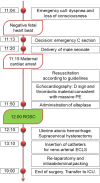Dilemma Diagnosis Between Pulmonary Embolism and Amniotic Fluid Embolism During First Stage of Labor-A Case Report
- PMID: 39555203
- PMCID: PMC11567775
- DOI: 10.1002/ccr3.9579
Dilemma Diagnosis Between Pulmonary Embolism and Amniotic Fluid Embolism During First Stage of Labor-A Case Report
Abstract
We report the sudden onset of dyspnea and loss of consciousness and fetal bradycardia in a middle-aged obese nulliparous woman at 39 weeks of gestation during first stage of labor leading to the decision for emergency cesarean section. Still during surgery, the mother underwent cardiac arrest. Transesophageal echocardiography during resuscitation showed right ventricular failure leading to the diagnosis of pulmonary embolism. Return of spontaneous circulation was achieved after emergency administration of thrombolysis with alteplase and cardiopulmonary resuscitation after 40 min. Severe bleeding, coagulopathy and persistent right ventricular failure resulted in persistent hemodynamic instability leading to supracervical hysterectomy and veno-arterial extracorporal life support. Both mother and baby survived without hypoxic brain injury.
Keywords: amniotic fluid embolism; cardiac arrest; emergency thrombolysis; pregnancy; pulmonary embolism; veno‐arterial.
© 2024 The Author(s). Clinical Case Reports published by John Wiley & Sons Ltd.
Conflict of interest statement
The authors declare no conflicts of interest.
Figures


References
-
- Sultan A. A., West J., Tata L. J., Fleming K. M., Nelson‐Piercy C., and Grainge M. J., “Risk of First Venous Thromboembolism in and Around Pregnancy: A Population‐Based Cohort Study,” British Journal of Haematology 156, no. 3 (2012): 366–373. - PubMed
-
- Knight M., Bunch K., Felker A., et al., Saving Lives, Improving Mothers' Care‐Lessons Learned to Inform Maternity Care From the UK and Ireland Confidential Enquiries Into Maternal Deaths and Morbidity 2017–19 (Oxford: National Perinatal Epidemiology Unit, University of Oxford, 2021).
-
- Knight M., “Antenatal Pulmonary Embolism: Risk Factors, Management and Outcomes,” BJOG 115, no. 4 (2008): 453–461. - PubMed
-
- “Guideline of the German Society of Gyecology and Obstetrics, Induction of Labour.” S2k, AWMF Registry No. 015–088. 2020.
-
- Konstantinides S. V., Meyer G., Becattini C., et al., “2019 ESC Guidelines for the Diagnosis and Management of Acute Pulmonary Embolism Developed in Collaboration With the European Respiratory Society (ERS),” European Heart Journal 41, no. 4 (2020): 543–603. - PubMed
LinkOut - more resources
Full Text Sources

